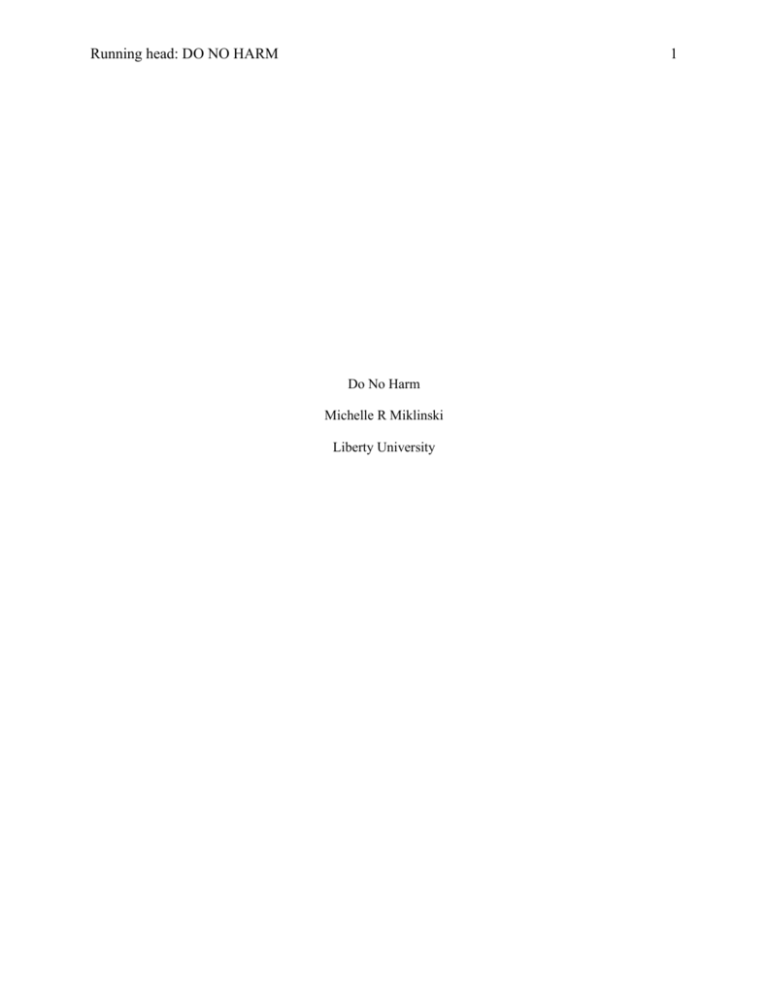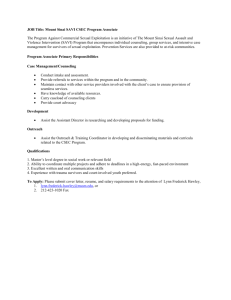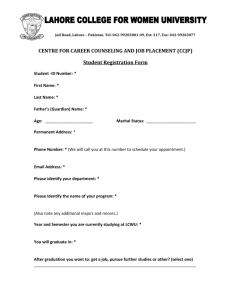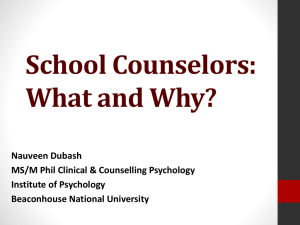
Running head: DO NO HARM
1
Do No Harm
Michelle R Miklinski
Liberty University
DO NO HARM
2
Abstract
To “Do No Harm,” is the emphasis of ethical practice in counseling relationships. This article is a review
of similarities and differences between the codes of conduct brought forth by, “The American Counseling
Association” and “The Association of Christian Counselors”. Section one highlights these similarities
and explains ethical issues related to the counseling relationship as they pertain to: The Counseling
Relationship, Confidentiality and Privacy, Professional Responsibility, Relationships with other
Professionals, Supervision, and Resolving Ethical Issues. Section two identifies three essential aspects of
the ethical code and initiates a discussion on: Confidentiality, Conflict of Interest (Dual Roles), and
Sexual Intimacies. A special discussion on examining ethical issues pertaining to multicultural/diversity
competence is included and a controversial look at the ethical issues related to conversion and reparative
therapy which is a type of sexual orientation change effort that attempts to change the sexual orientation
of a person from homosexual or bisexual to heterosexual.
DO NO HARM
3
Do No Harm
To, “Do No Harm” is the underlying value that has brought forth the need for ethical standards in
professional relationships between clients and therapists. The primary purpose of a code of ethics
according to Corey, Corey, and Callanan (2010), is to safeguard the welfare of clients by providing what
is in their best interest. (p. 9). Codes of ethics strive to fulfill three major objectives: to educate
professionals, to provide mechanisms of accountability, and to aid in the improvement of the professional
environment. These codes are guidelines for the professional to ensure that they are acting responsibly in
their practice and are taking into account the values, rights, and diversity of their clients. The American
Counseling Association and the American Association of Christian Counselors are two organizations that
have standardized a code of ethics that they believe foster a positive, safe, and moral guideline for their
profession.
The American Counseling Association (2005) states that, “The mission of the American Counseling
Association is to enhance the quality of life in society by promoting the development of professional
counselors, advancing the counseling profession, and using the profession and practice of counseling to
promote respect for human dignity and diversity”. The Christian counterpart to the ACA is the “AACC,”
American Association of Christian Counselors whose principles are based on the biblical foundation that
puts Jesus Christ at the center of its mission and to abide by the revelation of the New and Old Testament
which first seeks to love man and to protect the dignity of human personhood and the sanctity of Christian
values. Both groups take into account the counseling relationship as it pertains to: the counseling
relationship, confidentiality and privacy, professional responsibility, relationships with other
professionals, supervision, and resolving ethical issues.
DO NO HARM
4
Section One
The Counseling Relationship
The primary role of the counselor is to respect the dignity and promote the welfare of his client. The
ACA and the AACC stress an importance to the active involvement of the client in all aspects of the
treatment. It is the duty of the counselor to keep the client informed of their rights, voluntary consent,
treatment, and authority to obtain records of their treatment plan. Clients have the freedom to choose
whether they want to actively participate in the counseling relationship or when they feel that progress is
no longer viable, to terminate the counseling partnership. Counselors will respect the diversity of the
client and will not impose on their cultural beliefs or enforce their own values, attitudes, and beliefs on
the participant. (ACA, p. 4)
The ACA and AACC prohibit all forms of sexual misconduct as it pertains to the counseling
relationship. “Due to the inherent power imbalance of helping relationships and the immoral nature of
sexual behavior outside of marriage, such apparent consent is illusory and illegitimate”. (AACC, 1-130)
All sexual relations are considered unethical whether they occur during the therapeutic counselor/client
interaction or after the therapeutic relationship. The ACA states that relationships with former clients,
their romantic partners, or their family members are prohibited for a period of five years. (ACA, 2010, p.
5) However, The American Association of Christian Counselors prohibits any such contact whether past,
present, or future. They do not offer a statute of limitations and believe that these relationships should be
strictly forbidden. Furthermore, it is the standard of both associations to limit or even frown upon dual
relationships that occur outside of the therapeutic environment; these encounters would include; personal,
business, and financial involvement. Two exceptions noted by each association include, relationships that
are deemed beneficial to the client or in the context of marriage. The ACA requires detailed
documentation explaining the nature of the interactions, the benefits gained from the relationship, as well
as plausible consequences and must be initiated with the proper client consent. The ACCA will condone
the marriage of former relations if (1) counseling relations were properly terminated, and not for the
purpose of pursuing marriage or romantic relations, (2) the client is fully informed that any further
DO NO HARM
5
counseling must be done by another, (3) there is no harm or exploitation of the client or the client’s family
as a result of different relations with the counselor, and (4) the marriage takes place two years or more
after the conclusion of a counseling or helping relationship. (ACCA, 1-133)
Confidentiality, professional responsibility, counselor relationships with other professionals,
supervision, and the resolution of ethical issues are also considered and explained in detail though out the
associative documents. Respecting client rights to privacy, multicultural diversity, and proper disposal
of client records are discussed. It is the responsibility of the professional to report ethical violations,
resolve conflicts between ethics and laws, and to practice only within the boundaries of their confidence.
(ACA, 2005, p. 9) Supervisors must maintain a professional relationship with their students and trainees.
These include the same ethical standards discussed between the counselor and the client.
DO NO HARM
6
Section Two
Confidentiality
First and foremost, confidentiality is the cornerstone of ethical practice in the relationship between
client and therapist. Without confidentiality trust, honesty, and the rights of the client are put into
jeopardy. Counselors exhibit confidentiality when they protect the rights of their clients through the
right to privacy, disclosure of therapeutic information with the knowledge and consent of the client, and
sensitivity to the multicultural, diversity, and values of the client. Both, the ACA and the AACC
strongly endorse the value of confidentiality in the counseling relationship. Differences do however
exist between the two associations when it comes to the personal values of the individual. Although both
maintain sensitivity to differing views, advocating of such views, differ based on the moral values of
Jesus Christ that are found in the New and Old Testament. Section 1-120 of the AACC code of ethics
states, “Christian counselors refuse to condone, advocate for, or assist the harmful actions of clients,
especially those that imperil human life from conception to death. We agree that the protection of human
life is always a priority value in any professional or ministerial intervention. We will not abandon clients
who do or intend harm, will terminate helping relations only in the most compelling circumstances, and
will continue to serve clients in these troubles so far as it is humanly possible. (AACC, 2004) In other
words, priorities are given to the counsel, care, and commitment of the client however advocacy for
personal choices such as, abortion, infidelity, assisted suicide, and gender preference cannot be morally
condoned. The AACC also confirms, “We may agree to and support the wish to work out issues of
homosexual and transgendered identity and attractions, but will refuse to describe or reduce human
identity and nature to sexual reference or orientation, and will encourage sexual celibacy or biblically
proscribed sexual behavior while such issues are being addressed. (1-126)
DO NO HARM
7
Conflict of Interest (Dual Roles)
Conflict of interest relates to the extrinsic relationship of the client and counselor whether the nature
of the relationship is friendship, business related, financially induced, or any other event that is not in
communion with the professional relationship and has not been fully documented to be for the sole
purpose of benefiting the therapeutic process. This type of dual relationship can disrupt the professional
balance of the client/counselor paradigm of the psychosocial and spiritual influence and the inherent
power imbalance of helping relationships. The ACA and AACC are in agreement with the possible harm
that can be attributed to the dual relationship mixing professional relations with informal community.
Sexual Intimacies
Nothing can be more damaging or inflict harm on the counseling relationship than that of sexual
intimacy between the counselor and client, especially as it relates to the spiritual counsel between a
church member and ordained official. Trust, objectivity, moral, and professional integrity are sacrificed
when such relations interfere with the counseling relationship. Unintended and irreparable damage can
and most likely will occur if the hierarchal line of teacher and student blur and become entangled, this
breach in respect to the counseling relationship is not only ethically wrong but morally, spiritually, and
professionally corrupt.
1-102; No Harm or Exploitation Allowed prohibitively reinforces that Christian counselors avoid every
manner of harm, exploitation, and unjust discrimination in all client-congregant relations. Christian
counselors are also aware of their psychosocial and spiritual influence and the inherent power imbalance
of helping relationships—power dynamics that can harm others even without harmful intent. (AACC,
2004) The ACA reiterates this school of thought by prohibiting the act of sexual relations among
counselor and client.
Finally, one major conflict of interest between the secular and Christian counselor is that of ethical
issues pertaining to multicultural/diversity competence and a controversial look at the ethical issues
DO NO HARM
8
related to conversion and reparative therapy which is a type of sexual orientation change effort that
attempts to change the sexual orientation of a person from homosexual or bisexual to heterosexual. The
ACA cautions against it while the AACC willingly offers it to those who come into counseling with a
genuine desire to be set free of homosexual attractions and leave homosexual behavior and lifestyles
behind. Either goal of heterosexual relations and marriage or lifelong sexual celibacy is legitimate and a
function of client choice in reparative therapy. (AACC, 2004)
DO NO HARM
9
References
American Association of Christian Counselors. (2004). AACC Code of Ethics, 1-35.
American Counseling Association. (2005). ACA Code of Ethics, 1-20.
Corey, G., Corey, & Callanan. (2010). Issues and Ethics in the Helping Professions. Belmont,
CA: Brooks/Cole.








